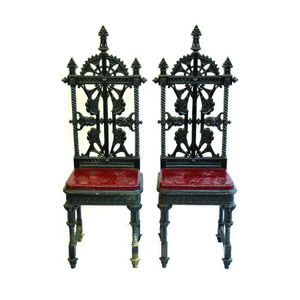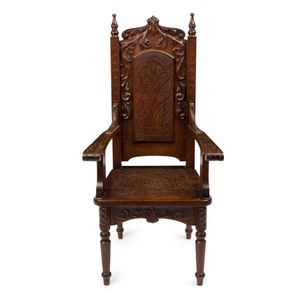Victorian Mother of Pearl Inlaid Papier Mache Chairs
You must be a subscriber, and be logged in to view price and dealer details.
Subscribe Now to view actual auction price for this item
When you subscribe, you have the option of setting the currency in which to display prices to $Au, $US, $NZ or Stg.
- Japanning - Japanning is the early eighteenth century technique used by European craftsmen to imitate the oriental style lacquer work that became popular in England, France, the Netherlands, and Spain in the 17th century.
The lacquer used was based on the lac beetle dissolved in alcohol (as used in French polish) and differed from the Chinese lacquer which was based on tree sap.
Each layer of the lacquer was allowed to dry and then sanded down. It was applied over cream, yellow, green, red, or black grounds. Japanning using gold leaf was also widely used with lacquer work. The technique can be found on bureaux, cabinets, chests, longcase clocks, and chairs. - Circa - A Latin term meaning 'about', often used in the antique trade to give an approximate date for the piece, usually considered to be five years on either side of the circa year. Thus, circa 1900 means the piece was made about 1900, probably between 1895 and 1905. The expression is sometimes abbreviated to c.1900.
- Column - An architectural feature sometimes used for decorative effect and sometimes as part of the supporting construction. Columns should generally taper slightly towards the top. They may be plain or decorated with carving, fluting or reeding. Columns may be fully rounded or, more commonly, half-rounded and attached with glue, screws or pins to the outer stiles of doors, or the facing uprights on cabinets and bureaux.
- Rail - A term used by cabinet makers for the horizontal sections of the frame of an item such as a chair or settee which have a front rail, a back rail and two side rails, and also on a door or carcase, where the rails are joined to the vertical framings.
- Mother-Of-Pearl - Mother-of-pearl, technical name "nacre", is the inner layer of a sea shell. The iridescent colours and strength of this material were widely used in the nineteenth century as an inlay in jewellery, furniture, (especially papier mache furniture) and musical instruments.
In the early 1900s it was used to make pearl buttons. Mother-of-pearl is a soft material that is easily cut or engraved.
Nowadays it is a by-product of the oyster, freshwater pearl mussel and abalone industries. - Inlay - Decorative patterns inserted into the main body of a piece of furniture, generally in wood of contrasting colour and grain, though brass, ivory, ebony, shell and sometimes horn have been used. Inlay may consist of a panel of well figured timber inset into a cabinet door front, geometric patterns, or complex and stylized designs of flowers, swags of foliage, fruits and other motifs. As a general rule, in pieces where the carcase is constructed in the solid, the inlay is relatively simple such as stringing, cross banding and herringbone banding. Where more elaborate and decorative work was required veneer was used. Inlay has been fashionable from at least the latter half of the 17th century, when a variety of elaborate forms were developed
- Victorian Period - The Victorian period of furniture and decorative arts design covers the reign of Queen Victoria from 1837 to 1901. There was not one dominant style of furniture in the Victorian period. Designers used and modified many historical styles such as Gothic, Tudor, Elizabethan, English Rococo, Neoclassical and others, although use of some styles, such as English Rococo and Gothic tended to dominate the furniture manufacture of the period.
The Victorian period was preceded by the Regency and William IV periods, and followed by the Edwardian period, named for Edward VII (1841 ? 1910) who was King of the United Kingdom and the British Dominions and Emperor of India for the brief period from 1901 until his death in 1910. - Splat - The central back support between the top rail and the seat in chairs and couches. They may take a variety of forms, and run either horizontally or vertically.
- Manner of .... / Style of ..... - A cataloguing term where the item, in the opinion of the cataloguer is a work in the style of the artist, craftsman or designer, possibly of a later period.
This item has been included into following indexes:
Visually similar items

A set of six French oak Louis XIII-style chairs, circa 1880s, the tall backs with a combination of pierced and carved splats, verticals and barley twists, a cane seat in the traditional 'hole to hole' pattern above barley twist and carved legs supported by

A pair of Coalbrookdale cast iron hall chairs designed by Christopher Dresser c.1870 in the 'Lily' pattern, the decorative backs with a combination of fluted, fan and wrythen forms, conforming base, the cast iron seats with enamelled dark red brown button

School of Robert Prenzel carver chair, blackwood, early 20th century decorated with carved orchids monogram and dated 'E.Y.C. 6th Sept. 1904' 53 cm across the handles

A striking pair of carved Anglo-Burmese chairs with leather studded cushion seats, circa 1840
